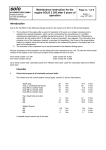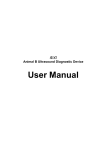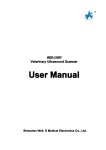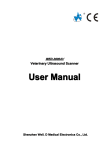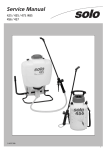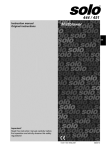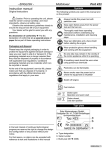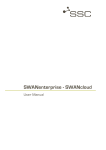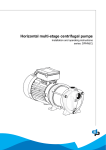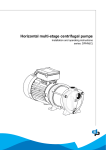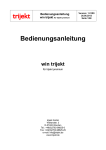Download Service-manual - SOLO Kleinmotoren GmbH
Transcript
solo service Service-manual For the aircraft engines solo 2 625 01 solo 2 625 02 solo 2 625 02i solo Kleinmotoren GmbH Stuttgarter Str. 41 D 71069 Sindelfingen Tel.: (0049) 7031 - 3010 Fax.: (0049) 7031 – 301195 Edition 2 dated October 1st.2010 Baureihe 2 625 01 2 625 02 2 625 02 i Service Manual SOLO KLEINMOTOREN GMBH Table of contents 1 2 3 4 4.1 4.2 4.3 4.4 4.5 4.5.1 4.5.2 4.5.3 4.6 4.6.1 4.6.2 4.7 4.7.1 4.7.2 4.7.3 4.7.4 4.8 4.8.1 4.8.2 4.8.3 4.8.4 5 6 1 General hints and description of the engines ............................................................ 2 Necessary tools ........................................................................................................ 4 Disassembly of the engine ........................................................................................ 5 Check of the individual parts ..................................................................................... 6 Cylinder heads.......................................................................................................... 6 Cylinders................................................................................................................... 6 Piston and piston rings ............................................................................................. 6 Crankshaft ................................................................................................................ 7 Ignition system.......................................................................................................... 7 Engines 2625 01 and 2625 02 .................................................................................. 7 Troubleshooting ignition systems.............................................................................. 8 Wire diagrams Iskra and ducati ignition systems ...................................................... 9 Engine Control Unit (ECU)...................................................................................... 10 Wire diagram ECU 2625 02 i .................................................................................. 10 Wire diagram redundancy system of the engine 2625 02 i ..................................... 11 Carburettor.............................................................................................................. 12 Specialties MIKUNI BN 38 ..................................................................................... 12 Specialties MIKUNI BN 38-34-55............................................................................ 13 Adjustment of the carburettors ................................................................................ 14 Troubleshooting at the carburettors ........................................................................ 15 Trouble shooting at the fuel injection system (only 2625 02 i) ................................ 16 Engine does not start .............................................................................................. 16 Failures during operation ........................................................................................ 16 Failure memory ....................................................................................................... 16 Software for the ECU .............................................................................................. 16 Assembly of the engine........................................................................................... 18 Notes....................................................................................................................... 20 General hints and description of the engines This service – manual shall give the engine specialist necessary hints for repairs and overhauls for the engine and help him solving specific problems. General knowledge of two-stroke-engines should be present. This Service-manual is valid together with the engine-manual and the spare-partslist. ! Attention! Because this engine is used as a certified engine for motor gliders the national authorizations of the specific certifying staffs must be maintained. edition 2 dated 1.10.2009 Seite 2 Baureihe 2 625 01 2 625 02 2 625 02 i Service Manual SOLO KLEINMOTOREN GMBH Description of the engines The aircraft engines 2625 01, 2625 02 and 2625 02i are based on the same engine block and differ only by different carburetors or at the engine 2 625 02i by the use of an electronic fuel injection. The engines 2625 02 and 2625 02i have a different cylinder with a different port timing of the intake port. All three engines are watercooled two cylinder two-stroke engines with piston-ports. They have a displacement of 625 cm3 with a stroke of 69 mm and a bore of 76 mm. They are lubricated by a fuel-oil mixture. For all engines a breaker less double ignition is used. Aircraft engine 2625 01 This engine has one diaphragm carburetor, which feeds both cylinders and a take-off power of 39 kW at a speed of 6.250 RPM. Aircraft engine 2625 02 This engine has a different intake-port timing compared to the engine 01 and two diaphragm carburetors. The take-off power is 47 kW at a speed of 6.500 RPM Aircraft engine 2625 02i This engine is based on the engine 2625 02, which is converted according to the Service bulletin TM 4603 – 3 to the version with electronic fuel injection. The carburetors and the ignition system are replaced by this electronic fuel injection system into the manifolds and also by an electronic ignition system. The former ignition system is replaced by an alternator, which supplies sufficient electric energy to operate the fuel injection and the ignition. The take-off power is 50 kW by a speed of 6.500 RPM. An ECU is controlling the injected amount of fuel and the ignition timing based on the engine speed, the position of the throttle valve, the engine temperature, the ambient pressure and the outside air temperature. This guaranties that the engine is running under optimal conditions. In order to achieve maximum security in case of a breakdown of the ECU a simple redundancy system is installed, which supplies the engine with two additional injection valves. An ignition module which is driving the two coils of the engine is integrated in this system. The system is controlled by an additional RPM-sensor. Other sensors are not necessary. The engine management system is consisting of the following components: • • • Pre-filter, fuel pump, micro filter and fuel pressure regulator for the fuel supply. The fuel pressure in the system is regulated by the pressure regulator at 3 bars. The fuel line from the pressure regulator back to the fuel tank is pressure less. Engine Control Unit with ignition modules and a pressure sensor, which measures the atmospheric pressure. In the ECU the maps for fuel injection and ignition timing are stored. Based on the air pressure and the air temperature the ECU calculates the correct amount of injected fuel. The engine has 5 sensors. Facing the flywheel of the alternator there is an RPM sensor. At the throttle valve there is a sensor, which measures the opening of the shutter valve. At the rear cylinder head there is a temperature sensor measuring the coolant temperature. Near the air filters there is a edition 2 dated 1.10.2009 Seite 3 Baureihe 2 625 01 2 625 02 2 625 02 i • • Service Manual SOLO KLEINMOTOREN GMBH sensor measuring the intake air temperature. In the ECU there is a pressure sensor measuring the atmospheric pressure. A double throttle valve assembly and one injection valve each, which are controlled by the ECU. Two double ignition coils with ignition wires leading to the front and rear cylinder each. The engine is running with minimal power loss fired by only one coil. If a sensor fails or a wire breaks standard values are stored in the ECU which guarantee a limited operation of the engine. Only if the speed sensor fails the engine stops. The ECU supplies constantly values about speed, temperatures and the condition of the sensors via a CAN-bus, which can be displayed to the pilot. In addition to that there is a failure memory, which can be read by the manufacturer. With this memory it can be detected, if one or more values have exceeded their limits. Short above the maximum engine speed the ignition is cut off. The starting of the engine must always be in idle position. A choke or other fuel enrichment systems are not necessary. The ECU has a serial interface, which allows the detection of the status of the ECU in operation. Special software is necessary for that. The settings and the access to the failure memory are protected by a password. 2 Necessary tools In order to conduct an expert repair or check it is necessary to use functional tools in good condition. Except the usual tools, present in each engine workshop the following special tools are necessary. Pos. SOLO order No. 1 2 3 4 00 80 529 00 80 530 00 80 314 5 6 7 8 00 83 177 edition 2 dated 1.10.2009 Description Puller for hub Puller for Ignition flywheel Pressure tester Two stroke oil Castrol ACT>EVO, Castrol Super Two Stroke, Other oils with specification JASO FC or FD Air filter oil Loctite 274 Loctite 270 Loctite 574 Seite 4 Baureihe 2 625 01 2 625 02 2 625 02 i Service Manual SOLO KLEINMOTOREN GMBH 3 Disassembly of the engine Pos. 1 2 3 4 5 6 7 8 9 10 11 12 13 Operation Clean engine before disassembly Disassemble carburetor from manifold Disassemble muffler, clean muffler from debris and coal. Loosen flywheel of the ignition system and pull off flywheel with suitable puller. Disassemble the stator of the ignition system completely. If the engine has an ignition system from Ducati disassemble also the plate with the pick-ups. Loosen hub at the front end of the crankshaft and pull off with the suitable puller. Loosen nuts at the cylinder head. Lift cylinder head. Mark cylinder head, cylinder and piston for matching. Loosen nuts at the bottom of the cylinder and lift cylinder carefully. Disassemble the piston-pin lock carefully. Push piston-pin out of the piston by hand. Loosen the 4 bolts on the side of the crankcase and move the two halves of the crankcase apart carefully so that they don’t get out of line. Clean both parts. ATTENTION! ON ENGINES WITH DOUBLE BEARING ON THE DRIVE SIDE LOOSEN THE FOUR BOLTS AT THE FRONT-END FIRST. Take off seals, locks and outer rings of the roller bearings by hand. edition 2 dated 1.10.2009 Seite 5 Tools, aid Use fuel Open end spanner 13 mm Allen key 6 mm Puller SOLO-No. 00 80 530 Socket wrench 19 mm Puller SOLO No. 00 80 529 Socket wrench 13 mm Open end spanner 12 mm Baureihe 2 625 01 2 625 02 2 625 02 i Service Manual SOLO KLEINMOTOREN GMBH 4 Check of the individual parts 4.1 Cylinder heads • • • Clean the inside part of the cylinder head from coal. Fuel can dissolute rests of burnt oil. Heavy oil-carbon deposit can be removed with a steel brush. Check both threads for the spark-plugs if damaged Clean the sealing surface. 4.2 Cylinders • • Check the cylinder surface (Coating) visually if there are damages (Scratches). Check the diameter of the cylinder in direction of the crankshaft and rectangular: Dimension 10 mm below top 30 mm below top 25 mm above bottom • • • New 76 mm +/- 0,005 76,mm +/- 0,005 76 mm +0,01 Wear limit 76,01 mm 76,01 mm 76,02 mm Check visually the grooves for the o-rings at the top of the cylinder. Check the entire cylinder for cracks or damages of the sealing surfaces. Remove oil-carbon deposit on the coating and in the exhaust port. 4.3 Piston and piston rings • • Remove oil-carbon deposit on the piston top carefully. Check piston diameter. Measure the diameter rectangular to the piston pin boss. Dimension D1=DN 22 mm above bottom D2: 59,5 mm above bottom D3: 69 mm above bottom • • New 76 mm +/- 0,06 Wear limit 75,9 mm 76 mm +/- 0,08 75,8 mm 76 mm - 0,093 75,7 mm Check vertical play of the piston rings New 0,05 mm - 0,10 mm wear limit 0,20 mm Check wear of the piston rings. Distance between the two ends if the piston ring is mounted into the cylinder: New 0,2 - 0,35 mm wear limit 0,8 mm No light has to be seen between cylinder wall and piston ring if the cylinder is hold against a lamp. edition 2 dated 1.10.2009 Seite 6 Baureihe 2 625 01 2 625 02 2 625 02 i Service Manual SOLO KLEINMOTOREN GMBH 4.4 Crankshaft The Crankshaft can be disassembled only by the manufacturer. The main bearings at the drive side or the ignition side (roller bearings) can be replaced. To conduct this, the inner rings must be grinded carefully on one spot until only 0.3 mm of wall thickness is left. Then they can be cracked by using a chisel. After that they can be slipped off the shaft. • Check true running on a centering device. The eccentricity at the bearings should not exceed 0.04 mm. If the eccentricity is more the crankshaft can be adjusted by the manufacturer. • Check axial play at the con-rod bearings. The play must be between 0.35 und 0.5 mm. 4.5 Ignition system 4.5.1 Engines 2625 01 and 2625 02 Following ignition systems are used: • ISKRA – Magneto Ignition with generator 12 V, 70 W for the engine 2 625 01 up to serial-No. 12. • DUCATI - Magneto Ignition with generator 12 V, 150 W for the engine 2 625 02 from serial-No. 1 and for the engine 2 625 01 from serial-No. 13. Both ignition systems have two independent ignition circuits. 4.5.1.1 Specialties of the Iskra ignition system This ignition system has a stator which can be adjusted on the crankcase. The proper ignition timing is adjusted if the stator is turned as far as possible against the rotational direction of the engine (anti clockwise). The ignition timing can only be checked with a strobe light while the engine is running in idle. 4.5.1.2 Specialties of the Ducati ignition system The ignition timing is fixed and cannot be adjusted. The proper position of the external pick-ups for the two circuits stand for the ignition timing. The ignition timing (22 ° BTDC) can be checked with the strobe light while the engine is running in idle. Therefore there are marks on the pick-ups and the rotor which have to match. Then the correct angle can be checked statically. edition 2 dated 1.10.2009 Seite 7 Baureihe 2 625 01 2 625 02 2 625 02 i 4.5.2 Service Manual SOLO KLEINMOTOREN GMBH Troubleshooting ignition systems • No spark on one Ignition circuit o Wire defect on one wire from the pick-ups or at a wire to the ignition coil. o Wire from one pick-up to the ignition coil has connection to ground. o The shut-off-wire for one circuit has connection to ground o The relating ignition coil has a defect. This can be checked if the wires to coil 1 are exchanged with the ones to coil 2. If the defect is moving to the other circuit the coil has to be replaced. o If the defect is not moving then a coil in the stator or one of the pickups have to be replaced. • No spark on both ignition circuits o Wire defect at the wires to the ignition coils. o Wires from the pick-ups or from the generator coils to the ignition coils have connection to ground. o Shut-Off-wires have connection to ground. • No charging current o o o o Wire defect at the wires from the coils to the stabilizer. Wires to the stabilizer have connection to ground. Plugs at the stabilizer have a defect. Are all previous defects not present the stabilizer has to be replaced. edition 2 dated 1.10.2009 Seite 8 Baureihe 2 625 01 2 625 02 2 625 02 i Service Manual SOLO KLEINMOTOREN GMBH 4.5.3 Wire diagrams Iskra and ducati ignition systems • Iskra ignition system • Ducati ignition system edition 2 dated 1.10.2009 Seite 9 Baureihe 2 625 01 2 625 02 2 625 02 i SOLO Service Manual KLEINMOTOREN GMBH 4.6 Engine Control Unit (ECU) The following wire diagram shows the connection between the ECU and the various components of the engine. The functions of the ECU where described in chapter 1. The wire diagram of the redundancy system is shown below. 4.6.1 Wire diagram ECU 2625 02 i 15 ● CANH CANL ● ● 25 7 Butterfly valve 4 ● 2 ● 31 ─ Computer interface 2 3 5 ● ● ● 3 ● ▼ ▼ IV2 IV1 26 Txd 35 1 1 20 ─ 2 ─ 17 8 Rxd ─ ─ ─ ─ ─ ─ ─ ─ ─ ─ ─ ─ ─ ─ ─ ─ ─ 19 20 ─ ─ ─ ─ ─ ─ ─ ─ ─ ─ ─ ─ ─ ─ ─ ─ ─ ─ 37 38 ─ ─ ─ ─ ─ ─ ─ ─ ─ ─ ─ ─ ─ ─ ─ ─ ─ ─ 55 36 54 37 55 Shielded 21 3 41 4 + 42 4 - + IC 1 10 52 ─ IC 2 53 ─ ● ● Ignition switch Relay ─ ─ ─ T-Air 31 Ground T-Water ─ ● 31 15 Ground 4 HV ● 15 + 4 HV ● 30 + ● 15 ─ 31 + ─ Fuel pump 15 = Switched positive 30 = Continous positive 31 = Ground 4 = High voltage ignition wire Ground throttle valve transducer 5 Volts throttle valve transducer Signal throttle valve transducer 7 25 CAN L CAN H 8 26 Computer interface Rxd Computer interface Txd 17 35 Injection valve 1 (Alternator side) Injection valve 2 (Drive side) 21 3 Temperature transducer air Temperature transducer coolant (CAN bus) (CAN bus) edition 2 dated 1.10.2009 ─ 31 41 42 Ignition coil 1 (Alternator side) Ignition coil 2 (Drive side) 10 Relay fuel pump 53 54 RPM transducer (Induktive) Ground RPM transducer 36 54 Ground Ground 37 55 Switched positive Switched positive 18 Continous positive Seite 10 30 + 31 ─ Battery Plug connection ECU 1 20 2 18 ∩ Ind. Sensor ─ 31 Baureihe 2 625 01 2 625 02 2 625 02 i SOLO Service Manual KLEINMOTOREN GMBH 4.6.2 Wire diagram redundancy system of the engine 2625 02 i GND ─ GND ─ GND ─ BAT ─ BAT ─ RPM ─ ZS ─ ZS ─ EV ─ ▼ ▼ IV2 IV1 31 ─ ─ ● 15 4 + 4 - + IC 1 ─ IC 2 ─ ● ● Ignition switch Relay ─ ─ ● 15 ● 30 Ind. Sensor ─ 31 ● 30 15 = Switched positive 30 = Permanent positive 31 = Ground 4 = High voltage ignition wire 4 HV ● 30 + 4 HV ● 30 + ─ 31 + ─ Fuel pump :Switched positive :Switched positive GND GND :Ground :Ground EV :Injection valve 1 and 2 ZS ZS :Ignition coil :Ignition coil RPM GND :RPM sensor :Ground RPM sensor edition 2 dated 1.10.2009 Seite 11 31 ─ Battery ─ 31 Steckerbelegung TBD BAT BAT 30 + ─ 31 Baureihe 2 625 01 2 625 02 2 625 02 i Service Manual SOLO KLEINMOTOREN GMBH 4.7 Carburettor Two types of carburetors are used: • MIKUNI BN 38 Diaphragm carburetor without fuel-pump • MIKUNI BN 38 - 34 - 55 Diaphragm carburetor without fuel-pump The engine 2 625 01 has one carburetor. The engine 2 625 02 has two carburetors. 4.7.1 Specialties MIKUNI BN 38 The carburetor has an integrated main jet which controls about 75% of the fuel at wide open throttle. This jet cannot be changed. Any fine adjustment can be conducted with the needle marked with “H”. The normal setting of that needle is one turn open. Typically the setting should be slightly leaner (7/8 turns open). The low-speed needle is marked with „L“. The typical setting is ½ turn open and should not be changed. edition 2 dated 1.10.2009 Seite 12 Baureihe 2 625 01 2 625 02 2 625 02 i Service Manual SOLO KLEINMOTOREN GMBH 4.7.2 Specialties MIKUNI BN 38-34-55 The carburetor has an exchangeable main-jet marked for 2 625 01 by 127.5 (engine 2625 02 has 117.5). This jet controls 75% of the fuel at wide open throttle. The carburetor is adjusted by the manufacturer in a way that the needle which is accessible from outside (marked “H”) the engine can be adjusted leaner up to ¼ of a turn. The needle-top has a plastic part which allows an adjustment of ¼ of a turn only. The needle must be in the left (counterclockwise) end position. The leaner adjustment is only necessary on airfields above 1.000 m above sea level. The low-speed needle is marked with „L“. The typical setting is ½ turn open and should not be changed. edition 2 dated 1.10.2009 Seite 13 Baureihe 2 625 01 2 625 02 2 625 02 i Service Manual SOLO KLEINMOTOREN GMBH 4.7.3 Adjustment of the carburettors The adjustment is almost identical with both types of carburettors. Before you start the basic needle adjustment should be made (see chapter 4.6.1 and 4.6.2). Engine 2 625 01 with one carburettor • • • • The Exhaust gas temperature (EGT) can be measured through a hole in the exhaust manifold which is shaped like a Y 100 mm after the cylinder flange with a Ni-CrNi thermo-couple. It is enough to measure in one of the two legs of the manifold. Start the engine and warm up the engine until the water reaches a temperature of 40°C. Adjust the idle speed with the idle speed screw until the engine runs between 2.300 and 2.600 RPM. At wide open throttle measure the EGT and wait until that temperature reaches a stable max. value. (After approx. 3 minutes). The carburetor should be adjusted so that the EGT is between 630 and 640 °C. Don’t adjust too early because you then could set the carburetor too lean. Engine 2 625 02 with two carburettors • • • • • • The carburetor adjustment is almost identical for both types. The typical setting should be made first. (see above „specialties“) The Exhaust gas temperature (EGT) can be measured through a hole in the exhaust manifold which is shaped like a Y 100 mm after the cylinder flange with a Ni-CrNi thermo-couple. It is necessary to measure in both legs of the manifold. Start the engine and warm up the engine until the water reaches a temperature of 40°C. Adjust the idle speed with the idle speed screw until the engine runs between 2.300 and 2.600 RPM. Both idle speed screws should be adjusted so that the EGTs reach 230 °C +- 20°C. In order to have a good start the air filters can be removed first and the two throttles can be so adjusted that the opening angle is identical at 1 mm open. At wide open throttle measure the EGT and wait until that temperature reaches a stable max. value. (After approx. 3 minutes). The carburetor should be adjusted so that the EGT is between 630 and 640 °C. Don’t adjust too early because you then could set the carburetor too lean. The difference between the two EGTs should not exceed 30°C. edition 2 dated 1.10.2009 Seite 14 Baureihe 2 625 01 2 625 02 2 625 02 i Service Manual SOLO KLEINMOTOREN GMBH 4.7.4 Troubleshooting at the carburettors • Setting too lean Lean setting can be detected if the engine does not accelerate properly or if the EGT is too high. o Check typical setting of the adjustment needles first. o Clean the carburettor after removing the diaphragm-cover. The clean remove idle and high speed adjustment screws. Clean all openings with pressurized air. Clean also the fuel inlet with pressurized air. o After reassembly of the inlet needle the proper sealing of the valve has to be checked. It is necessary to use the pressure tester (see above). Disconnect the fuel line and apply 0.4 bar of pressure to the carburetor. The pressure-loss should not accede 0.1 bars per minute. If an electric fuel pump is installed, the check can be conducted with this pump. First remove the diaphragm cover and switch on the pump. No fuel should flow out of the valve. o Adjust the carburetor as described above. • Setting too rich Rich setting can be detected if power is low (RPM), shaking of the engine and loss of RPM below 3.000 m above sea level. o Check typical setting of the adjustment needles first. o Replace air-filter or clean filter mesh (wash with fuel and dry with compressed air) o Check the proper sealing of the inlet valve. It is necessary to use the pressure tester (see above). Disconnect the fuel line and apply 0.4 bar of pressure to the carburetor. The pressure-loss should not accede 0.1 bars per minute. If an electric fuel pump is installed, the check can be conducted with this pump. First remove the diaphragm cover and switch on the pump. No fuel should flow out of the valve. o Adjust the carburetor as described above. edition 2 dated 1.10.2009 Seite 15 Baureihe 2 625 01 2 625 02 2 625 02 i Service Manual SOLO KLEINMOTOREN GMBH 4.8 Trouble shooting at the fuel injection system (only 2625 02 i) 4.8.1 Engine does not start No fuel Check the fuel lines and the function of the fuel pump. No spark at both spark plugs Weak battery, charge the battery. Broken wire No spark at one spark plug Spark plug defect. Ignition coil defect. Ignition wire broken. 4.8.2 Failures during operation Engine overheats Not enough coolant. Water pump defect. Fuel pressure not sufficient. Engine does not reach Fuel pressure not sufficient. Fuel filter clogged. Throttle full power valve does not open completely. Spark plugs defect. Fuel pump defect. 4.8.3 Failure memory The ECU has a failure memory, which detects failures at the system and stores them. Only the manufacturer can read the memory. For an analysis the ECU has to be sent to the manufacturer. 4.8.4 Software for the ECU On the page http://www.trijekt.de/downloads-10.html software (Win trijekt) can be downloaded, which allows to connect a computer to the serial interface of the ECU. After installing the software the status of the ECU can be checked. Connect the serial cable to the computer and the ECU and start the software. Then switch the ignition (ECU) to “ON”. If the software shows „connected“the status of the sensors and the ECU can be checked. edition 2 dated 1.10.2009 Seite 16 Baureihe 2 625 01 2 625 02 2 625 02 i Service Manual SOLO KLEINMOTOREN GMBH The status window shows the status of the sensors, the injection time and the ignition angle during engine operation. Check the following indications: No. Of rev. errors: If the number of rev. Errors increases during starting or engine operation, a failure of the speed sensor can be indicated. Check sensor and wires. Throttle potentiometer In idle position the value should be around 10 degrees and during full throttle 90 degrees. With other readings the sensor is defect. Engine temperature Check the engine temperature with a second gauge if it is plausible. Air temperature Check the air temperature with a second gauge if it is plausible. Air pressure (int.) This value can be checked with an altimeter. Other sensors are not connected. edition 2 dated 1.10.2009 Seite 17 Baureihe 2 625 01 2 625 02 2 625 02 i Service Manual SOLO KLEINMOTOREN GMBH 5 Assembly of the engine Before assembly apply two-stroke oil on crankshaft bearings, pistons and piston pins. Operation 1 2 3 4 5 6 7 8 9 Tool, aid Heat inner rings of roller bearings up to 180°C And slip on free ends of the crankshaft. The flange of these rings has to be next to the crank web. Attention! For engines with double bearing first slip on the ring with flange, then the spacer ring and then the ring without flange. All three rings must be positioned next to each other. Clean crankcase with thinner. Remove possible rests of former gaskets completely. Apply Loctite 574 on contact surfaces of the crankcase halves and put crankshaft into the lower half. Before that apply two-stroke oil on all bearings. Assemble all rings and seals together with the crankshaft. Mount other half of the crankcase plus the 4 bolts on both sides with Loctite and tighten with a torque wrench. Attention! On engines with double bearings mount the steel liner with the two lower bolts first. Then tighten the four bolts on the sides of the crankcase. Then tighten the 4 bolts on the front of the steel liner. Apply Loctite 274 on all bolts. Assemble piston with rings to the connecting rod and secure with piston-pin locks. Push piston pin into piston by hand. Apply two-stroke oil on all parts. Mount cylinders and mount nuts M8 so that the cylinders are still movable. Assemble intake manifold on engine 2 625 01 or exhaust manifold on engine 2 625 02 with gaskets in order to get cylinders in line. Then tighten the 4 nuts on each cylinder. Assemble cylinder heads Heating plate with temperature control Loctite 574 Two-stroke oil Torque wrench (12 Nm) Loctite 274 Piston ring clamp bent out of spring steel Torque wrench (20 Nm) Torque wrench (20 Nm) Plug all openings (Intake and exhaust ports) Pressure tester with steel parts and rubber parts in the shape of the flanges. Check if the engine block is sealed with 0.5 bar pressure. Pressure loss edition 2 dated 1.10.2009 Seite 18 Baureihe 2 625 01 2 625 02 2 625 02 i Service Manual SOLO KLEINMOTOREN GMBH should not exceed 0.1 bars per minute. 10 12 Assemble stator of the ignition system. Secure all bolts with Loctite. Assemble flywheel. Clean cone and flywheel with thinner first. Assemble exhaust manifold with gaskets. 13 Assemble carburettor on intake manifold. 14 Assemble air filter on carburettor. 15 Check sealing of the cooling system with a Pressure tester pressure of 1 bar. No pressure loss allowed. 11 edition 2 dated 1.10.2009 Seite 19 Torque wrench (12 Nm) Loctite 270 Torque wrench (80 Nm) Torque wrench (20 Nm) Loctite 270 Baureihe 2 625 01 2 625 02 2 625 02 i Service Manual 6 Notes edition 2 dated 1.10.2009 Seite 20 SOLO KLEINMOTOREN GMBH





















